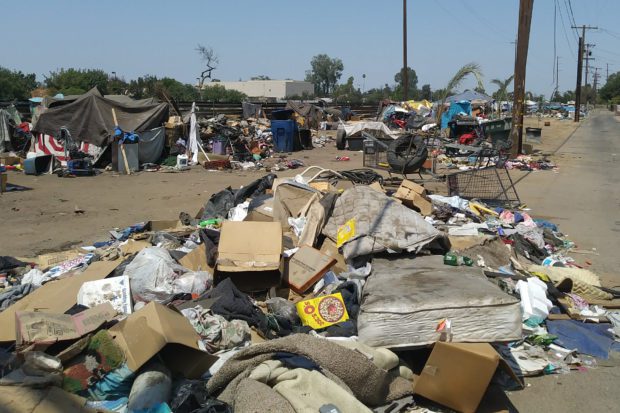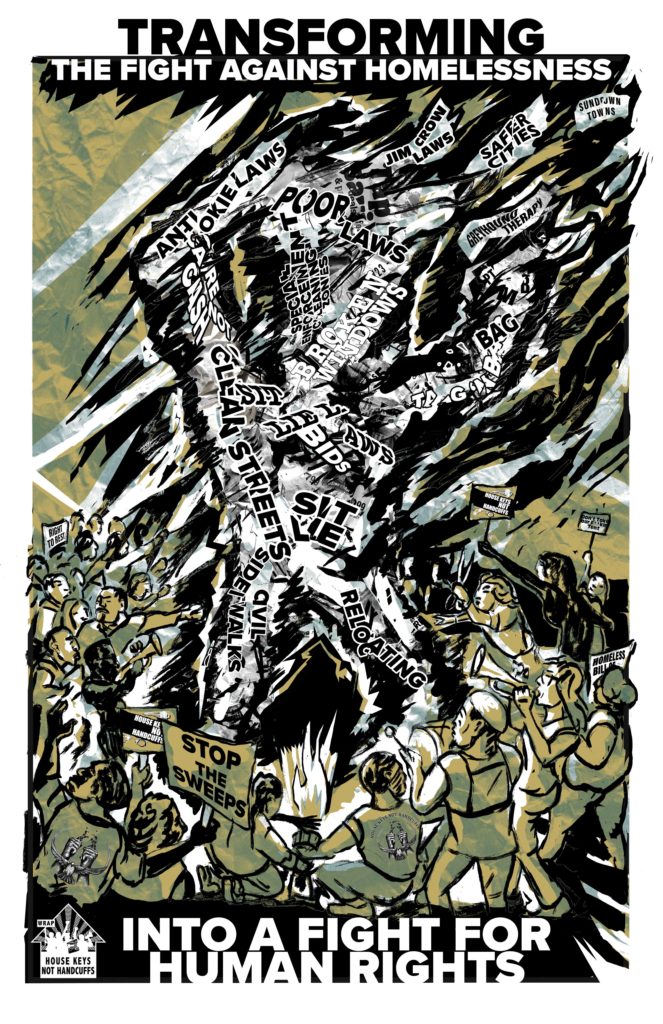

On Dec. 14, the Fresno Police Department’s Homeless Assistance Response Team (HART, aka the heartless team) raided a small homeless encampment behind a convenience store during a hard, cold rainstorm. According to the street family members on the scene, no shelter was offered, some of their belongings were thrown away and the police confiscated someone’s diabetes medication.
If these allegations are true, which is likely, all the actions taken by the police were illegal. This raid and other recent raids are conducted without adequate outreach. They are traumatic and disruptive to people already suffering greatly.
They violate recent federal court decisions and state and Centers for Disease Control guidelines during a resurgent deadly pandemic. Why wasn’t there adequate outreach?
Following the money, the City of Fresno announced it has $758,500 that it received in July provided by federal Homeless Housing, Assistance and Prevention funds for the purpose of funding a Homeless Outreach (HERO) team that will work with HART, the Coordinated Entry System and homeless service providers to “effectively engage, serve and stabilize the most vulnerable and at-risk individuals experiencing homelessness.”
The raids and other cruel and inhumane treatment of the unhoused come at a time when the City has $85.5 million in federal funding from the American Rescue Plan Act (ARPA)—meaning the public’s tax money—that it received in May 2021. Fresno County received $97 million in ARPA funding in May 2021, with the same amount to be allocated to the city and county again in May 2022. These funds can immediately be used to address the housing and homeless emergency. Doing so would save lives.
The American Rescue Plan is a federal stimulus plan approved by Congress and President Biden that provides $350 billion of stimulus funding to state and local governments out of the $1.9 trillion bill. Spending categories include public health, economic support for households and businesses, services to disproportionately impacted communities, overtime pay for essential workers, infrastructure/water/sewer/broadband and revenue replacement.
The City and County have released overly simplified surveys to the public and scheduled workshops and hearings in December. The entire process for public input has been inadequate, with little outreach and short notice with little time for community input, however, because of massive mobilization, the mayor’s proposed budget for the use of $38 million of the ARPA funds was partially thwarted because of massive public opposition at two recent City Council meetings.
Initially, Mayor Jerry Dyer proposed using $5.6 million for police vehicles (33 patrol cars, 15 undercover sedans, three undercover SUVs, three undercover pickups, eight motorcycles, one cargo van and one CSI van). The mayor proposed $2.1 million for police equipment and technology (Skywatch Maintenance, 15 SWAT unit vests, 15 rifles, SWAT EOTech with magnifier, universal night sight for rifles and infrastructure).
Other budget requests included $5 million for fire drills in schools, $2 million for the Fire Department over time, $2.5 million for essential workers’ overtime, $4.5 million for small business assistance, $13.2 million for new emergency shelters and permanent housing, and $250,000 for a mobile shower unit for the unhoused.
After hearing the testimony of more than 150 residents following a mobilization led by Faith in the Valley, some changes were made. All the community members who testified spoke against the funding for police. Everyone spoke for the need to invest in affordable housing, rent stabilization and legal representation for people getting evicted.
The Council approved most of the budget requests except for the police equipment technology category. They did approve $5 million for the purchase of police vehicles.
This expenditure must still be challenged because it has no direct link to the pandemic. It might qualify under the revenue replacement category, but the Council and the mayor did not respond to a request to show what revenues were lost due to the pandemic.
In addition, the Council approved $1 million in housing vouchers for the homeless, $13.2 million for new emergency shelters and housing, and $950,000 for Advance Peace, a successful violence prevention program.
The interim Treasury rule provides local governments with fairly wide latitude on how ARPA funding can be used to help economically disadvantaged communities, and Fresno can do better.
St. Louis, for instance, has committed nearly $72 million (about 16% of its total allocation) to help such communities, including shelter and services for the homeless, funds to prevent eviction and programs for young people.
Boston, Minneapolis and Seattle plan to dedicate significant ARPA dollars to address affordable housing needs and combat homelessness.
In Buffalo, N.Y., investment in city parks, especially in low-income neighborhoods and for child-related amenities, represents one of the largest planned expenditures.
Services to disproportionately impacted communities account for 21% of the $1.3 billion that 20 cities have thus far committed. Some cities that have announced plans not yet reflected in official reports—such as Detroit, Pittsburgh, St. Paul, Minn., and Austin, Texas—are poised to make large commitments in this area, too.
The City and County have had this money since May but waited until now to hold hearings—during the holidays when people are distracted and out of town. Another outrage is that while the City and County have been sitting on this funding, Fresno’s unhoused population is literally dying on the streets and sidewalks.
On National Homeless Persons’ Memorial Day, on the first day of winter, Dec. 21, the longest night of the year, those who have died with nowhere to call home were remembered.
Many people do not understand that prolonged exposure to homelessness has a significant negative effect on individuals that can result in death. Homelessness is much more than the absence of physical housing; it is a tension-filled, trauma-filled and treacherous condition that often results in injuries and fatalities.
Tragically and sadly, people who were homeless have been brought to county morgues where coroner office staff determined that they died by electrocution, thermal injuries, hypothermia, overdoses, environmental exposure, blunt force, injuries sustained in traffic accidents or being crushed to death by large objects such as garbage bins.
People die on the streets for untreated chronic conditions such as heart disease and diabetes. They die from medical neglect and because they are unable to get regular treatment for a serious medical condition. Now, they are also dying of Covid and, as in life, the unhoused are invisible in death.
Pandemic-related deaths are not being counted in the unhoused community across the United States, and many times the cause of death is recorded as unknown. There were more than a hundred deaths annually in the past few years among Fresno’s homeless before the pandemic. Almost certainly, the death rate has risen due to the pandemic. Who can be held responsible?
The mayor and the City Council can do more; the County can collaborate and share resources to do more. No one should die on the streets of Fresno. The City and County can take immediate steps to save lives.
They can open the Convention Center or other public buildings for emergency shelters; purchase trailers as temporary shelters; hire more outreach teams; urge shelters to allow people to stay there during daytime hours; and distribute tents, tarps, sleeping bags and warm clothes as if there is a disaster.
The current situation is a humanitarian disaster unfolding daily in plain sight. The City could clean up the trash, provide more sanitation stations and provide porta potties, and the County could provide more social services such as drug treatment programs and alcohol rehab services. The City can immediately use the $13.2 million allocated on Dec. 9 for a new shelter, housing and services for the unhoused.
Kelly Doran, M.D., poignantly says: “I work in a public hospital ER in New York City. Every single shift, I see multiple patients who are homeless and sick, some very sick. I see how homelessness makes people sick, and I see how our shelter, healthcare and other systems fail people.
“It makes me sad and angry. I’m talking to real people every single day, suffering the effects of homelessness. It informs everything else I do and doesn’t let me forget or turn away. I won’t be quiet. We all have to make this better.”
Contact the mayor, the City Council members and the County supervisors and tell them to use ARPA funding to help disadvantaged communities and to house the homeless.
*****
